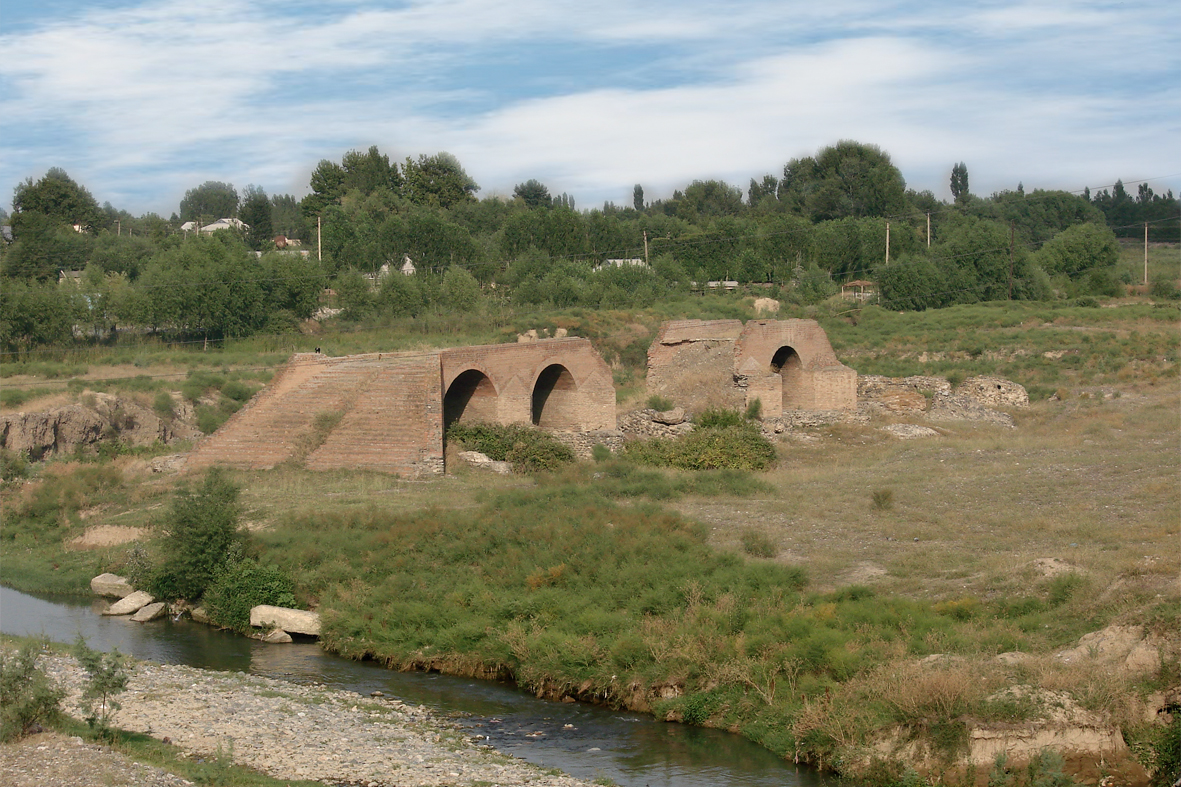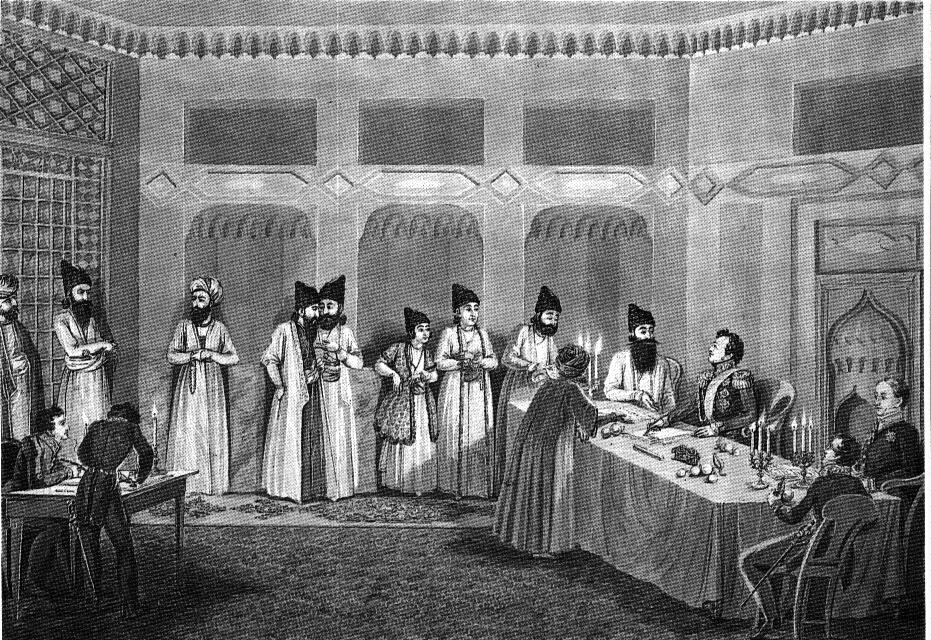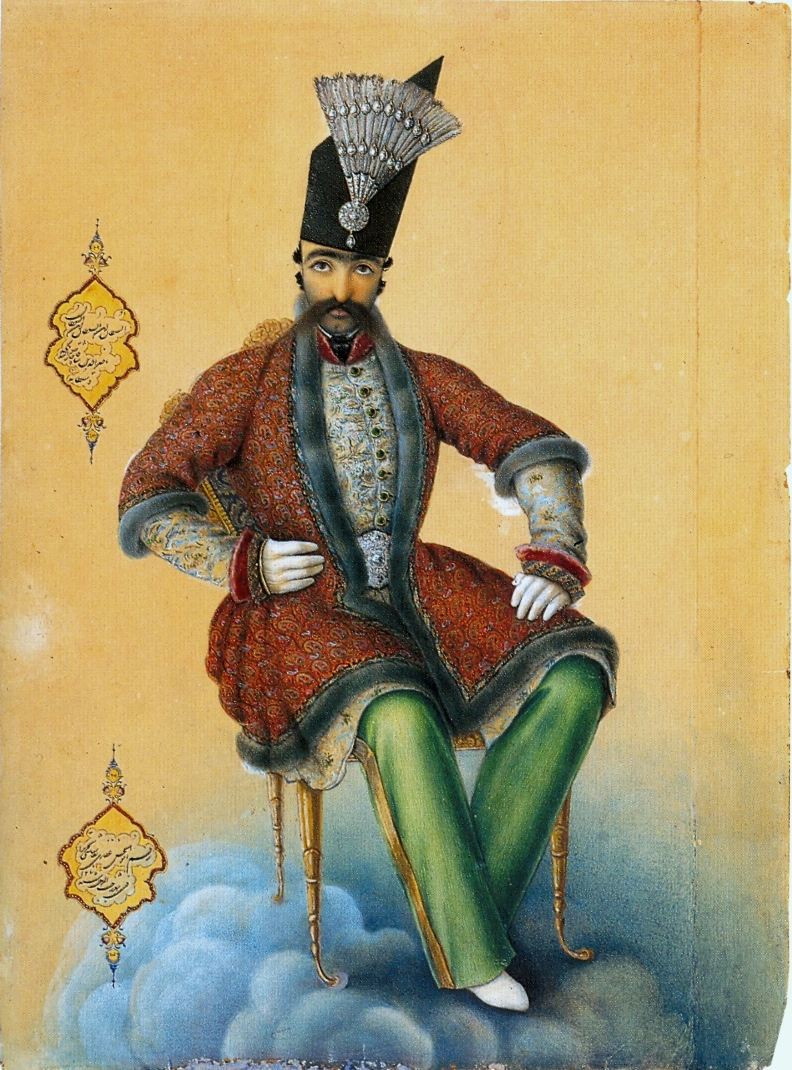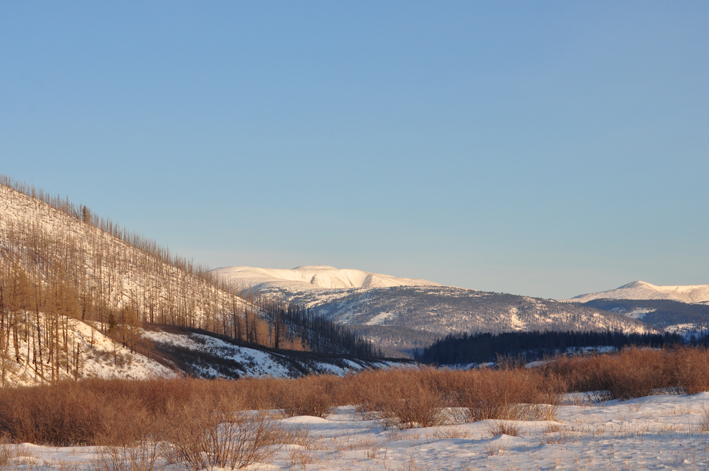|
Bahman Mirza Qajar Mausoleum
Bahman Mirza Qajar Mausoleum is a mausoleum with three domes located 25 meters north-east from Imamzadeh architectural complex in Barda. Design Bahman Mirza built this mausoleum in 1880 and bequeathed it to his sons to bury it here. The tomb is located 25 meters east of the Imamzadeh tomb. This architectural monument is one of the rare types in Arran's architectural style to be built with baked bricks. Its domes are consolidated from both inside and outside. Bahman Mirza Qajar was buried in the third room from entrance, which is also middle of the last room. The grave is built of a kind of tomb style. There are six inscriptions on the black marble on the inner walls of the dome. The texts are written in plain text, and the texts are related to the verses of the Koran: The life of the buried man is described as full of agony, frustration, longing, and shaking. The height from the floor to the dome is 1 meter. The walls of the tomb are 1 meter thick. Bahman Mirza The person buri ... [...More Info...] [...Related Items...] OR: [Wikipedia] [Google] [Baidu] |
Mausoleum
A mausoleum is an external free-standing building constructed as a monument enclosing the interment space or burial chamber of a deceased person or people. A mausoleum without the person's remains is called a cenotaph. A mausoleum may be considered a type of tomb, or the tomb may be considered to be within the mausoleum. Overview The word ''mausoleum'' (from Greek μαυσωλείον) derives from the Mausoleum at Halicarnassus (near modern-day Bodrum in Turkey), the grave of King Mausolus, the Persian satrap of Caria, whose large tomb was one of the Seven Wonders of the Ancient World. Historically, mausolea were, and still may be, large and impressive constructions for a deceased leader or other person of importance. However, smaller mausolea soon became popular with the gentry and nobility in many countries. In the Roman Empire, these were often in necropoles or along roadsides: the via Appia Antica retains the ruins of many private mausolea for kilometres ou ... [...More Info...] [...Related Items...] OR: [Wikipedia] [Google] [Baidu] |
Barda, Azerbaijan
Barda ( az, Bərdə ) is a city and the capital of the Barda District in Azerbaijan, located south of Yevlax and on the left bank of the Tartar river. It served as the capital of Caucasian Albania by the end of the 5th-century. Barda became the chief city of the Islamic province of Arran, the classical Caucasian Albania, remaining so until the tenth century. Etymology The name of the town derives from () which derives from Old Armenian ''Partaw'' ( Պարտաւ). The etymology of the name is uncertain. According to the Iranologist Anahit Perikhanian, the name is derived from Iranian *''pari-tāva-'' 'rampart', from *''pari-'' 'around' and *tā̆v- 'to throw; to heap up'. According to the Russian-Dagestani historian Murtazali Gadjiev, however, the name means "Parthian/Arsacian" (cf. Parthian ''*Parθaυ''; Middle Persian: ''Pahlav''; Old Persian: ''Parθaυa-''). The name is attested in Georgian as ''Bardav '. History Ancient According to '' The History of the Country of Al ... [...More Info...] [...Related Items...] OR: [Wikipedia] [Google] [Baidu] |
Bahman Mirza Qajar
Bahman Mirza ( fa, بهمن میرزا; 11 October 1810 – 11 February 1884) was an Iranian prince from the Qajar dynasty. The son of Abbas Mirza and grandson of Fath Ali Shah, he was Vicergerent ( ''vali'') of Azerbaijan and Governor-General of Tabriz. He later migrated to neighboring Imperial Russia, where he was received with great honour and lived a prestigious life in Shusha. Many of his offspring either returned to Iran where they pursued political or military careers, or served in the Russian military, and later played an important role in the military of Azerbaijan Democratic Republic. He is also the great-grandfather of Afrasiyab Badalbeyli, Azerbaijani composer and author of the first Azeri balet and the first ballet in the Muslim East. Bahman Mirza is the ancestor of the Bahmani family with the branches of the Russian Princes Persidskii, and the Bahmanov and Kadjar lines of Azerbaijan as well as of the Iranian families Bahmani-Qajar and Bahman. Thus, Bahm ... [...More Info...] [...Related Items...] OR: [Wikipedia] [Google] [Baidu] |
Imamzadeh Mausoleum (Barda)
Imamzadeh Mausoleum is a monument which consists of a mausoleum and mosque, located in the center of Barda. The monument, which was the only 4 minarets built in Azerbaijan in the 14th century, was in the form of a pilgrimage-mausoleum, according to academician Dorn. A mosque was built around it in the 18th century. Content Abbasqulu Agha Bakikhanov mentioned in his famous Gulistani-Iram work in 1841: "In many ways, the ruins of the village and the high-ranking three imamzadehs in the cities of Shamakhi, Ganja and Barda, Imamzadeh in the Bulbule village show that this country has always been the homeland of the religious elders" Gulistani-Iram 15, p.35-37 According to reports, 5th Imam of Ismaili and Jafari Shiite, Mohammed al-Baqir's granddaughter was buried here. Mohammed al-Baqir's third son, Ibrahim Isa, was buried in Goy Imamzadeh (in 739), 7th km of the city of Ganja. This monument is similar to the monument "Char Minar" in Bukhara. A.A.Bakikhanov also noted in his Gulista ... [...More Info...] [...Related Items...] OR: [Wikipedia] [Google] [Baidu] |
Bahman Mirza
Bahman Mirza ( fa, بهمن میرزا; 11 October 1810 – 11 February 1884) was an Iranian prince from the Qajar dynasty. The son of Abbas Mirza and grandson of Fath Ali Shah, he was Vicergerent ( ''vali'') of Azerbaijan and Governor-General of Tabriz. He later migrated to neighboring Imperial Russia, where he was received with great honour and lived a prestigious life in Shusha. Many of his offspring either returned to Iran where they pursued political or military careers, or served in the Russian military, and later played an important role in the military of Azerbaijan Democratic Republic. He is also the great-grandfather of Afrasiyab Badalbeyli, Azerbaijani composer and author of the first Azeri balet and the first ballet in the Muslim East. Bahman Mirza is the ancestor of the Bahmani family with the branches of the Russian Princes Persidskii, and the Bahmanov and Kadjar lines of Azerbaijan as well as of the Iranian families Bahmani-Qajar and Bahman. Thus, Bahman ... [...More Info...] [...Related Items...] OR: [Wikipedia] [Google] [Baidu] |
Arran (Caucasus)
Arran (Middle Persian form; Persian: ارّان), also known as Aran, was a geographical name used in ancient and medieval times to signify a historically-Iranian region which lay within the triangle of land, lowland in the east and mountainous in the west, formed by the junction of the Kura and Aras rivers, including the highland and lowland Karabakh, Mil plain and parts of the Mughan plain. In pre-Islamic times it corresponded roughly to the territory of modern-day Republic of Azerbaijan. The term is the Middle Persian''Journal of the Royal Asiatic Society of Great Britain and Ireland''. The Society, published 1902, page 64. Text states: ''"In Mustawfi's lists, however, the Arabic article has everywhere disappeared and we have Ray, Mawsil, etc.; while names such as Ar-Ran and Ar-Ras (spelt Al-Ran, Al-Ras in the Arabic writing), which in the older geographers had thus the false appearance of Arab names, in the pages of Mustawfi appear in plain Persian as Arran and Aras." ... [...More Info...] [...Related Items...] OR: [Wikipedia] [Google] [Baidu] |
Qajar Dynasty
The Qajar dynasty (; fa, دودمان قاجار ', az, Qacarlar ) was an IranianAbbas Amanat, ''The Pivot of the Universe: Nasir Al-Din Shah Qajar and the Iranian Monarchy, 1831–1896'', I. B. Tauris, pp 2–3 royal dynasty of Turkic origin,Cyrus Ghani. ''Iran and the Rise of the Reza Shah: From Qajar Collapse to Pahlavi Power'', I. B. Tauris, 2000, , p. 1William Bayne Fisher. ''Cambridge History of Iran'', Cambridge University Press, 1993, p. 344, Dr Parviz Kambin, ''A History of the Iranian Plateau: Rise and Fall of an Empire'', Universe, 2011, p. 36online edition specifically from the Qajar tribe, ruling over Iran from 1789 to 1925.Abbas Amanat, ''The Pivot of the Universe: Nasir Al-Din Shah Qajar and the Iranian Monarchy, 1831–1896'', I. B. Tauris, pp 2–3; "In the 126 years between the fall of the Safavid state in 1722 and the accession of Nasir al-Din Shah, the Qajars evolved from a shepherd-warrior tribe with strongholds in northern Iran into a Persian dynasty." T ... [...More Info...] [...Related Items...] OR: [Wikipedia] [Google] [Baidu] |
Abbas Mirza
Abbas Mirza ( fa, عباس میرزا; August 26, 1789October 25, 1833) was a Qajar crown prince of Iran. He developed a reputation as a military commander during the Russo-Persian War of 1804–1813 and the Russo-Persian War of 1826–1828, as well as through the Ottoman–Persian War of 1821–1823. He is furthermore noted as an early modernizer of Persia's armed forces and institutions, and for his death before his father, Fath Ali Shah. Abbas was an intelligent prince, possessed some literary taste, and is noteworthy on account of the comparative simplicity of his life. With Abbas Mirza as the military commander of the Persian forces, Iran lost all of its territories in the Caucasus comprising the South Caucasus and parts of the North Caucasus (Dagestan) to Russia in conformity with the 1813 Treaty of Gulistan and the 1828 Treaty of Turkmenchay, following the outcomes of the 1804–1813 and 1826–1828 wars. Biography Abbas Mirza was born on August 26, 1789 in Nava, M ... [...More Info...] [...Related Items...] OR: [Wikipedia] [Google] [Baidu] |
Ardabil
Ardabil (, fa, اردبیل, Ardabīl or ''Ardebīl'') is a city in northwestern Iran, and the capital of Ardabil Province. As of the 2022 census, Ardabil's population was 588,000. The dominant majority in the city are ethnic Iranian Azerbaijanis and the primary language of the people is Azerbaijani. Ardabil is known for its trade in silk and carpets. Ardabil rugs are renowned and the ancient Ardabil carpets are considered among the best of classical Persian carpets. Ardabil is also home to a World Heritage Site, the Ardabil Shrine, the sanctuary and tomb of Shaikh Safî ad-Dîn, eponymous founder of the Safavid dynasty. The population of Ardabil is about 650,000 with the majority of them being Shia Muslims. Etymology The name Ardabil comes from the Avestan ''artavil'' or ''artawila'' which means "holy place". Location Ardabil is located on the Baliqly Chay River, about from the Caspian Sea, and from the city of Tabriz. It has an average altitude of and ... [...More Info...] [...Related Items...] OR: [Wikipedia] [Google] [Baidu] |
Mohammad Shah Qajar
Mohammad Shah (; born Mohammad Mirza; 5 January 1808 – 5 September 1848) was the third Qajar ''shah'' of Iran from 1834 to 1848, having succeeded his grandfather Fath-Ali Shah. From a young age, Mohammad Mirza was under the tutelage of Haji Mirza Aqasi, a local dervish from Tabriz whose teachings influenced the young prince to become a Sufi-king later in his life. After his father Abbas Mirza died in 1833, Mohammad Mirza became the Crown Prince of Iran and was conferred the title of Governor of Azarbaijan. Not long after, Fath-Ali Shah died on his way to Shiraz, leading some of his sons—including Ali Shah Mirza and Hossein Ali Mirza—to revolt but Mohammad Shah, with the support of his grand vizier, Abol-Qasem Qa'em-Maqam, suppressed the rebellions and asserted his authority. Mohammad Shah ordered the removal, imprisonment and eventual execution of Qa'em-Maqam, which led to appointment of Aqasi as the grand vizier. One of Mohammad Shah's main goals was to reconquer t ... [...More Info...] [...Related Items...] OR: [Wikipedia] [Google] [Baidu] |
Naser Al-Din Shah Qajar
Naser al-Din Shah Qajar ( fa, ناصرالدینشاه قاجار; 16 July 1831 – 1 May 1896) was the fourth Shah of Qajar Iran from 5 September 1848 to 1 May 1896 when he was assassinated. He was the son of Mohammad Shah Qajar and Malek Jahan Khanom and the third longest reigning monarch in Iranian history after Shapur II of the Sassanid dynasty and Tahmasp I of the Safavid dynasty. Nasser al-Din Shah had sovereign power for close to 51 years. He was the first modern Persian monarch who formally visited Europe and wrote of his travels in his memoirs. A modernist, he allowed the establishment of newspapers in the country and made use of modern forms of technology such as telegraphs, photography and also planned concessions for railways and irrigation works. Despite his modernizing reforms on education, his tax reforms were abused by people in power, and the government was viewed as corrupt and unable to protect commoners from abuse by the upper class which led to incr ... [...More Info...] [...Related Items...] OR: [Wikipedia] [Google] [Baidu] |
Genghis Khan
''Chinggis Khaan'' ͡ʃʰiŋɡɪs xaːŋbr /> Mongol script: ''Chinggis Qa(gh)an/ Chinggis Khagan'' , birth_name = Temüjin , successor = Tolui (as regent) Ögedei Khan , spouse = , issue = , house = Borjigin , dynasty = Genghisid , regnal name = Genghis Khan () , temple name = Taizu () , posthumous name = Emperor Fatian Qiyun Shengwu () , father = Yesügei , mother = Hoelun , religion = Tengrism , birth_date = , birth_place = Khentii Mountains, Khamag Mongol , death_date = (aged 64–65) , death_place = Xingqing, Western Xia , burial_place = Unknown(presumptively Ikh Khorig, Burkhan Khaldun, Khentii Province) Genghis Khan (born Temüjin; ; xng, Temüjin, script=Latn; ., name=Temujin – August 25, 1227) was the founder and first Great Khan ( Emperor) of the Mongol Empire, which became the largest contiguous empire in history after his death. He came to power by uniting many of the noma ... [...More Info...] [...Related Items...] OR: [Wikipedia] [Google] [Baidu] |
.jpeg/1200px-Taj_Mahal_(Edited).jpeg)









